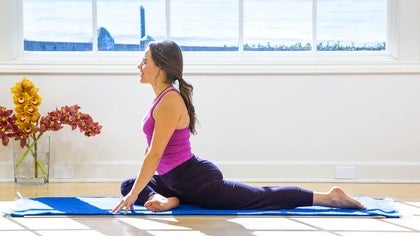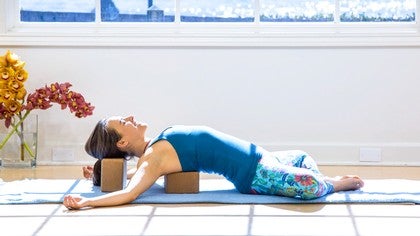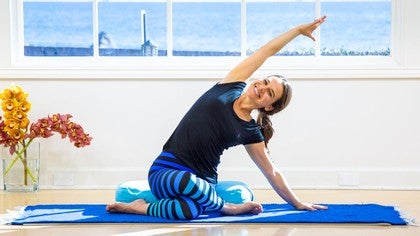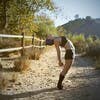Description
About This Video
Transcript
Read Full Transcript
Let's begin to explore some of the shapes and principles of yin yoga. So the magic ingredient to this practice is time. So we'll be offering ourselves to these yin shapes passively, anywhere from about two to five minutes in the interest of stretching or awakening what's called the connective tissue. So we'll begin in the shape of butterflies. So make sure you're cozy.
You might have a rug underneath you, a blanket, and we're going to bring the soles of the feet together, knees wide. So similar to a baddha konasana or boundegal shape, you might sit up on a blanket or some height just to encourage that anterior tilt of the pelvis. And so in the butterfly shape, the feet are away from the pelvis, so more of a diamond shape, nice and wide. And we'll just begin by taking our thumbs and kind of thumbing the inner leg lines, kind of easing into the stretch and the sensation through the hips, and then begin to thumb the soles of your feet, the massaging, the soles of the feet, inner arches, balls of the feet, toes, tops of the feet, ankles. And then gradually as you feel ready, begin to release into the forward fold.
And now depending on your body, you might have a bit of support under your head that might feel nice for your neck. And as you ease in, you might kind of wobble a little bit from side to side. So we'll be in this shape for about four minutes. That said, if and when you feel ready to come out of any shape, please do that. Please listen to your body.
So step one, notice the quality of your breath here in this shape. With the invitation to begin to breathe into where you feel the sensation. And most likely here, there's a kind of a dull, achy, maybe a warm, wide stretching of feeling around the spine, the neck, the low back, sacrum, and hips. As you notice the quality of your breath, check in with your face. And softening any layers of tension or holding, maybe through the mouth or the jaw.
Notice the quality through your hands, you might find allowing the hands to turn up towards the sky and encourages the quality of receptivity. And so here we're allowing gravity to assist us, perhaps feeling the head get heavy. We notice the relationship between the shoulders and the ears. One of the key principles in the practice is to feel and find an appropriate edge of sensation. And the sensation might feel initially like a wall of resistance.
And so the suggestion is when you feel that wall of resistance, when the body just begins to stop, breathing into the sensation. Having your exhalation to encourage the process of softening or releasing any edges or tension or sensation. So for the last few moments here, what would it feel like to allow the shape to have a bit more of you somehow? And then slowly as you feel ready, roll around your way back up to a seat. Taking a few moments as you come up to pause and notice how you feel.
Allow for a clearing breath, inhale and exhale. From here we'll transition onto our backs for windshield wipers. So just roll onto your back. You might bring that blanket under your head for a bit of support. Bend the knees, bring the soles of the feet wide and you might stretch your arms overhead and letting the knees begin to go side to side, cruising onto the edges of the feet.
And your head might roll away from the knees or with the knees. Just inviting this fluid movement into the body before coming into these or between these long static holds. A few more around side to side windshield wipers. And I find after a butterfly windshield wipers feels pretty delicious. Really nice through the hips, the spine, nice.
And then as you're ready, let the knees come back into your chest and rock from side to side. From here we're going to rock our way up into swans. You might roll to your side or use your arms to press yourself up. And then we'll transition into a table top position and set up for a swan, also known as pigeon. So we'll start with the left leg sliding the knee forward.
And you might have a blanket underneath your left hip there, any props to support the body. And you might choose to keep your foot close in towards the belly. Or you might toe heal the foot a little further away. And it's going to depend on your hips and the anatomy of your femur bones and the pelvis. So there might be a lot of sensation right here.
And you might pause. Check in with the eyes, the jaw, and any props useful to support the body here. And then gradually perhaps allowing the body to invite you in. So you might stay upright. You might begin to slowly release onto the forearms.
You'll be in this shape for about four minutes. Again, initially a little wobbling or movement from side to side might feel useful. And we're looking to feel and find that appropriate edge of sensation. If the sensation is incredibly overwhelming or if it feels like sharp, kind of searing, hot burning, painful, you'll want to come out of this shape or adjust so that it feels good. Many of these shapes are quite curious.
So really taking the time to investigate and find that appropriate edge of sensation which may change moment to moment, day to day. Notice the quality through your eyes, your face, your jaw, hands. And with the invitation to breathe into where you feel the sensation. Which might be quite obvious, right? Like in the hip, in the physical body, it might be where you feel the sensation might be a bit more subtle.
And notice what you choose to do with your head. And gradually over time we're offering ourselves to stillness. Stillness is another one of the key ingredients of the practice. You might find that as your body becomes more and more kind of quiet and still, you become aware of how crazy and wild the mind actually is. And if you find the mind is busy, active, wild while you're in these shapes, you might begin to tether your attention inward towards your breath.
And without straining or pushing or forcing the breath, you're riding the ocean of the breath. The inhale. And allowing for that full expression of the exhale. Perhaps becoming a bit more cozy or comfortable with the bottom of the exhalation, that feeling of the emptiness. You might notice how the sensation changes with a bit of time here in the shape with your attention and breath.
It's the beauty of this practice. Beautiful. And then as you feel ready, use the support of your hands to slowly walk your way back up. And just taking a moment to pause. And the transition will come into a child's pose.
So finding a way back that works for your body, I'm just gonna draw the left knee back. And then bringing the knees wide, big toes towards each other, and we'll be in this shape just for about a minute or so, just to pause between sides. The intention with pausing between sides is to begin to really notice and track the feeling tone and the results through the body. Nice, from child's pose, as you're ready, your way back up into tabletop, we'll find swan on the other side, so drawing the right knee forward. And then any support underneath your right hip.
So maybe it's a blanket or a bolster. And again, depending on this knee, this hip, this ankle, you might keep the right foot in close, or you might toe heal it a little further away, which usually tends to offer a bit more sensation through that right hip. So finding that appropriate spot for you on this side, on a wiggle. And then just gradually allowing the body to invite you in, really cultivating this quality of inward listening, or softening the sensory awareness inward towards the inner landscape of thoughts, feelings, sensations, emotions. And you might stay upright, you might lower down, and notice what you choose to do with your head, your hands, notice the quality through the face.
And as you arrive, you might allow for an inhale, and exhale. And softening the jaw, the belly. What would it feel like to allow the ground, the earth to have you, to have a bit more of you? Eventually, you're resting in a quality of stillness. All right.
And in the last minute or so here, you might consider imagining the muscles softening or melting around the bones, around the hip joint, allowing for this more kind of passive stretch. And Last few moments here. Going into where you feel the sensation or resistance, that edge. And then taking your time as you're ready, using your hands to walk yourself up. Taking a moment to pause, and then we'll slowly drop back again into a wide child's pose.
Drawing that right knee back, knees wide, big toes towards each other, and as you send your hips back towards your heels, we'll pause here for about a minute again. Taking and tracking any sensation through the hips, the pelvis, the legs. And from child's pose, allow for an inhale, inhale, exhale, exhale, exhale, exhale, exhale, inhale, and full exhale. When you feel ready, rise up into a table top, and we'll find some cat-couch just to move that through the body after stretching the outer hips. Tuck your toes under, just to stretch and open the connective tissue at the bottoms of the feet.
And we'll arch the back on the inhale, and then as you exhale, let your back round, drawing the navel towards the spine, chin towards the chest, kind of stretching the back body. And then let your inhale bring you into an extension, shoulders over the wrists, feeling that space through your collar bones, sitting bones, arching the back. And then again, exhale, round your back into cat, kind of pressing the earth away from you as you stretch and widen, and then inhale moving into your extension. A few more rounds at your own pace with your breath. You might keep the fingers pointing forward.
It might feel nice to spin the wrists away, fingers towards the knees, like exploring your cat-cowl. And any side-to-side movement that would feel nice in your spine, getting into the hips, the ribs, the shoulder blades up through the neck. And then as you're ready, spin your fingers back, they're pointing towards the knees, and we'll transition onto our bellies for a passive backbend. So coming into Sphinx pose, lowering yourself down, and then prop yourself up on your forearms. So in Sphinx, we want the elbows to be just slightly in front of the shoulder.
And we'll start with a more active Sphinx pose, so we know when we're engaging. So begin to get a sense of drawing your heart forward, feeling kind of this stretch through the thoracic part of the spine, upper back, and feel that you can kind of broaden your collar bones. You might feel some action through the buttocks, through the legs, drawing the shoulder blades down the back, feeling that length through the spine. Nice. And then from this active Sphinx pose, begin to relax the effort through the arms, so relaxing the muscles.
And as you relax the effort through the arms, relaxing the effort through the belly. And you might begin to release the weight of the head a bit. You find you'd like support under your head. You might bring a block under your forehead for your neck. And as you relax the belly, begin to relax through the pelvis, the buttocks, the legs.
Coming into a more passive, yin-like backbend. And I find this one is always a bit curious. So it's common to feel like a dull pooling of pressure around the low back, the lumbar spine just above the sacrum. So this is quite common with a passive backbend. And we'll be in this shape for a few more minutes.
That said, always, if and when you're ready to come out, when you're cooked, please lower down, letting the elbows go wide, forehead resting on the hands. And easing into sensation, noticing any areas where you can deliberately soften an eye's mouth, belly, noticing any areas through the lower body that are clenching or a little tight. Relax if it feels safe, allowing the muscles to relax a bit. And you might keep your head lifted, you might release the weight of the head, feeling that dull ache around the neck. And within the shape of the backbend, you might bring some attention towards your exhalation.
Again, rather than kind of pushing the breath out or forcing the exhale, as you bring your attention to it, it might naturally begin to lengthen. And oftentimes, bringing our attention to the exhalation within a backbend helps to kind of promote and stimulate the parasympathetic part of the nervous system. The last minute or so here, and feel that you can continue to soften through the lower belly and let the sacrum feel wide. Relax. Relax.
And then from sphinx, as you feel ready, slow, let the elbows go wide and let your forehead rest on the top of your hands. And resting for a moment in this stillness. And within this stillness, you might feel quite a bit of movement and flow, energy. And then from here, let your knees bend, a windshield wiper side to side, reverse, relaxing some of the effort through the lower back, through the buttocks, through the legs. And then releasing the tops of the feet, bring the hands underneath the shoulders, press our way up and back into another child's pose, knees wide and then sinking back for about a minute or so.
And I counter pose the back bend with a forward fold. And here in this shape, you might begin to draw your awareness towards the mid-low back area around the kidneys. Notice here how your breath responds with some attention. So our kidneys help to regulate, nourish the water element through our bodies. Then as you feel ready, slowly make your way up and we'll extend the legs out for a caterpillar pose.
Stretch your legs out and you might have a blanket underneath your sitting bones for support. We're going to stretch the legs out. So in the yin practice, it's different than pashimottanasana where we're lengthening or maybe grabbing the feet. In the yin practice, we're allowing the spine to round, so getting a bit slumpy through the spine, through your posture. With the intention of kind of stretching and awakening that connective tissue down the back of the legs, the spine, low back.
And you might release the weight of the head, you might support the head with your hands or a prop. So in this practice, the shapes are relatively simple, yet the practice is not so easy. As you can see, there's long windows of silence to be with ourselves, to be with the sensation arising through the body, the habitual thought patterns, our favorite worries, all of it. And so as you settle into this shape and perhaps a bit of stillness, notice the quality of your breathing, any areas you can soften and release. And you might notice how the shape evolves with time, again time being a magic ingredient here, breath and your attention.
Okay. Thank you. Last few moments here, what would it feel like to allow the shape to have a bit more of you? Then slow as you're ready, chin into your chest, roll and round your way up to a seat. Just taking a moment to pause and notice how you feel.
Oftentimes one of the best parts of these shapes is the feeling when you come out, after kind of marinating for a while, nice. From here we'll roll onto our back for a spinal twist. Open your way there, and start with the knees into the chest. If you'd like a blanket under your head, you might put one there. We'll keep our left knee into our chest and stretch the right leg out on the floor.
Letting the shoulders soften down the back, feeling the back of the neck nice and long and lengthening, easy in the eyes. With the left knee into the chest, we'll find a spinal twist to the right. You can bring your right hand on the outside of the left knee and then twisting over to the right. It's a one leg spinal twist with the right leg straight. If you're finding today that your lower back wants a bit more support or something different, you might just simply bend both knees and stack them on top of each other.
As you arrive, allow for an inhale, finding a bit of length through the spine, a bit of space. Then with the exhale, allowing the belly to really soften. In the spinal twist, we're intentionally squeezing, like we're wringing out a sponge or a rag. We're squeezing our internal organs and the lymphatic system. As we come out of a twist, there's a fresh soaking of blood or chi, also known as prana, moving through our system.
spinal twists also offer a nice counter pose to forward folds and back bends. For the last minute or so here, notice what you prefer to do with your neck and head. Again, it might be rolling away towards the left, it might be somewhere in the middle. You allow it to feel a bit more spacious between your eyebrows and the base of your skull around that occipital ridge. Allow the breath to be natural and comfortable, but be aware if the breath is held right or short or shallow and consider visualizing your mind's eye or two lungs, keeping it soft through the throat, you might imagine the lungs are revolving along with the rib cage towards the sky, as the left shoulder gets heavy towards the earth.
In these last few moments here, notice what you prefer to do with your left arm, it might be reaching straight out, it might be floating, it might be stretching it overhead a bit. And then slow as you're ready, just roll onto your back to unwind and stretch the left leg out on the floor. You might shake it out a bit through the legs and the arms and as you re-organize your pelvis and your spine, we'll pause for a moment in a starfish shape, so arms and legs out wide and allow yourself to take up space on the earth. Just tracking the feeling, the sensations through the body. Nice and allow for an inhale and exhale everything from your starfish collecting your limbs into the chest, and we'll find the other side, keep the right knee into the chest at first and stretch that left leg out on the floor, draw the shoulders down the back, long through the neck, and then we'll find a spinal twist to the left, so your left hand might rest on the outer right part of your knee as you come over to the left now, and then maybe stretching and reaching the right arm out of line from the shoulder, and well the suggestion is a one leg spinal twist with that right knee in, the left leg straight, depending on your back and body, you might choose to just simply bend both knees and stack them on top of each other.
And finding a place where your neck and head feel good and comfortable, you might ease in with an inhale and exhale softening the belly. You might find again that this side feels a little or a lot different, depending on your spine, your hip, your back, your knee. And you might keep your right arm where it is, you might explore stretching the right arm overhead or at a diagonal, and allowing for a soft bend through the shoulder. And for the last few moments here, you might come back into your lungs with your mind's eye, and perhaps feeling that gentle expansion of that relationship with the lungs, and stretching into the intercostals, into the ribcage, you feeling sensation through the belly. And then noticing how the shape morphs and evolves with a bit more time here.
And then slow as you're ready, roll onto your back, and then stretch that right leg out on the floor, and it might feel nice to just shake the legs out, the feet, nice, and we'll draw the knees back into the chest one last time, and wobble from side to side, just rocking yourself. And from here, stretching the legs out into the shape of Shavasana, and any support under your body that would feel nice under your head, your legs. And here in Shavasana, allowing yourself to take up space, consciously resting in the feeling tone through the body. And so the theory is that we have these internal pathways, these rivers, pathways carrying the prana or chi through our system. These pathways are referred to as meridians or nadis, might begin to feel or track or sense in the subtle energy currents moving through you, and allowing the muscles to soften, and allowing the bones to feel heavy, held by the earth.
Thank you. And so, as always, you're welcome to stay in Shavasana as long as you'd like. If and when you feel ready to transition, of allowing your breath to inspire movement through the body, the fingers, the toes, that might feel nice to stretch and lengthen the arms overhead, maybe pointing and flexing the feet, circling the ankles. And then just gradually allowing your knees to bend and rolling to your side, taking whatever time you'd like on your side to pause. When you're ready, use the support of your hands, keep the head heavy, and come up into a comfortable seat. You might grab a blanket underneath your sitting bones.
It's taking a moment to allow everything to settle, like water. Allowing your inhale to inspire a quality of length through the spine, the heart, the base of the skull, and allowing your exhalation to encourage the soft grounding quality through the pelvis, the hips, the legs. And from this space, joining the hands together at the heart, allow for an inhale, and generous exhale. Namaste. Thank you for your practice.
Yin Yoga: Alana Mitnick
Comments
You need to be a subscriber to post a comment.
Please Log In or Create an Account to start your free trial.



























